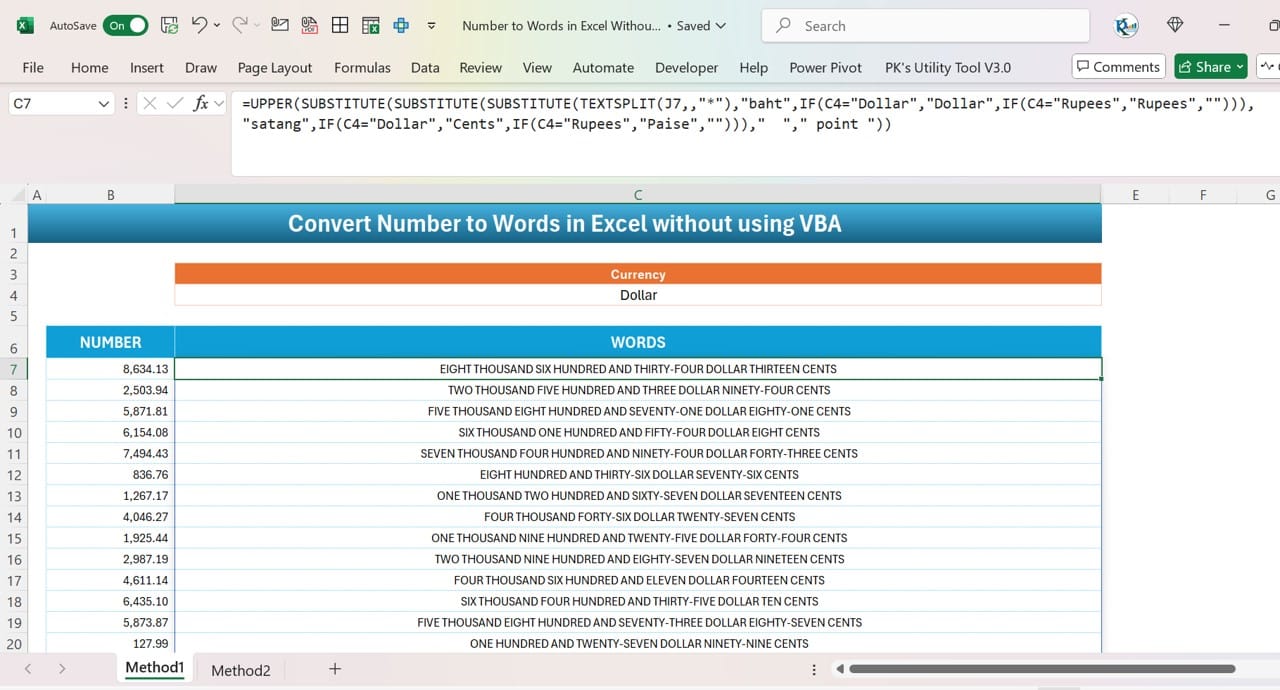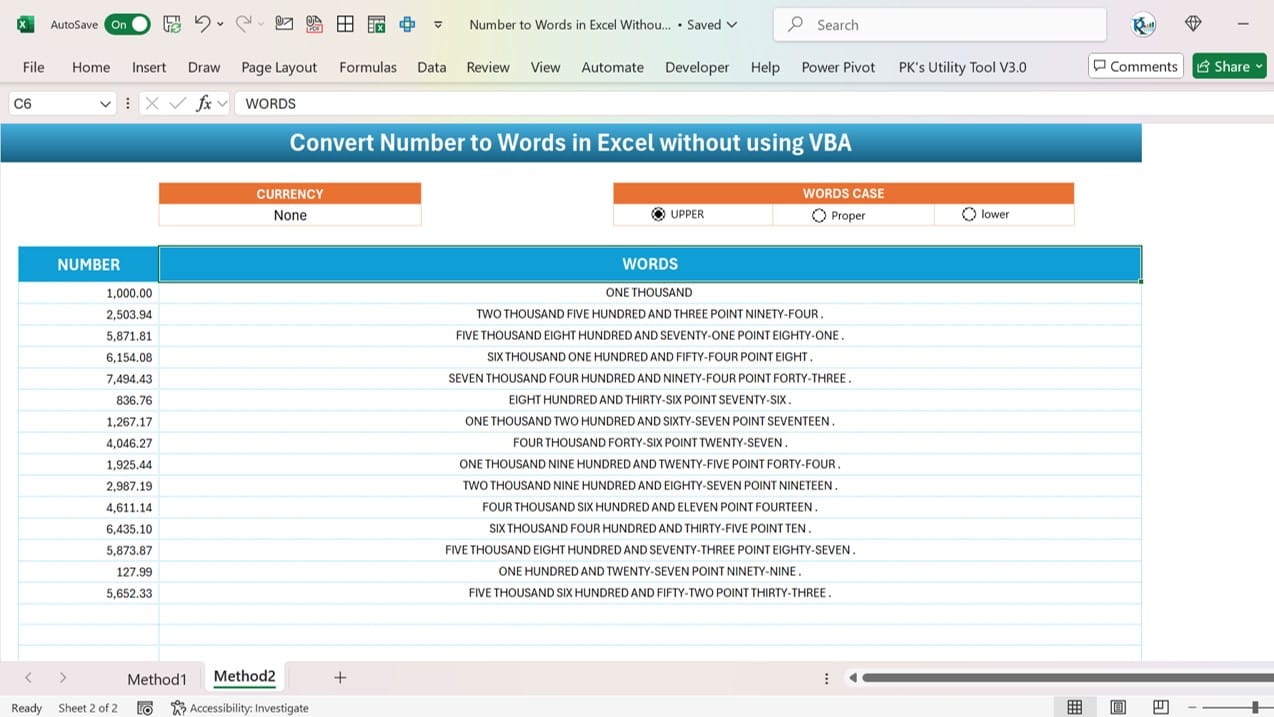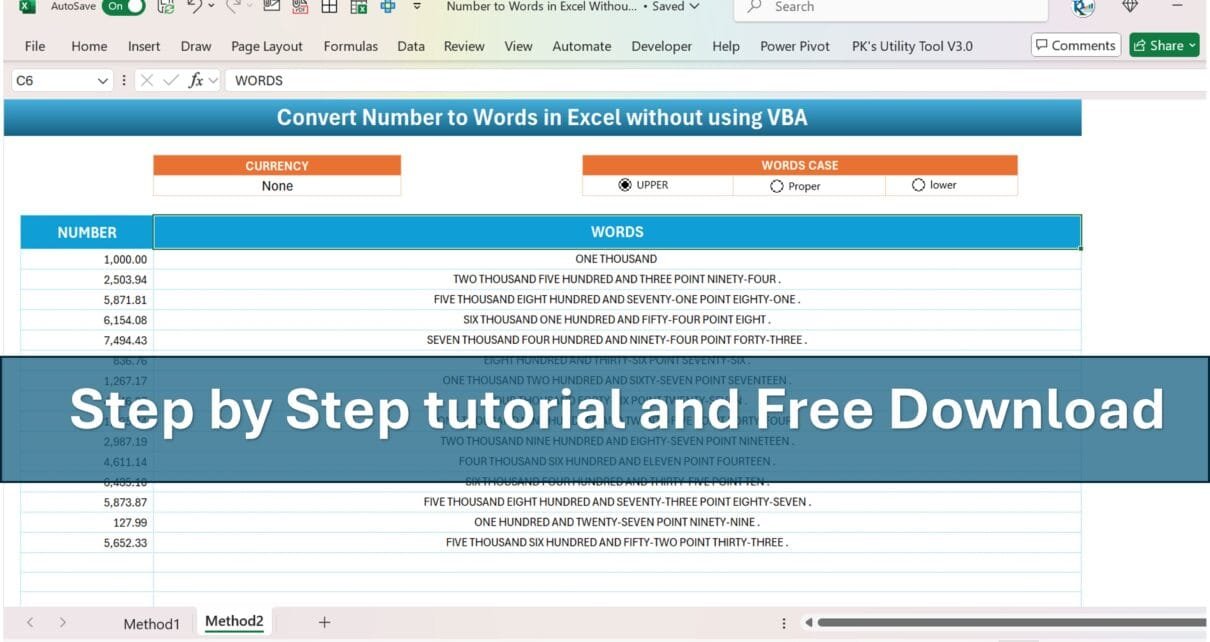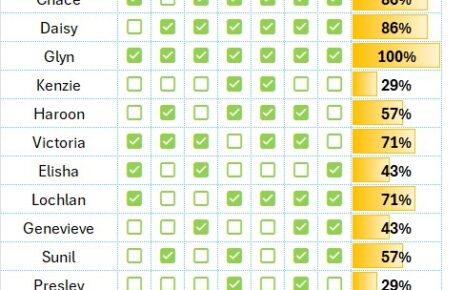In many documents, such as financial records, invoices, and legal papers, numbers need to be displayed in words. This conversion can prevent misinterpretation and clarify amounts, especially for checks and large payments. While Excel lacks a direct function to convert number to words in Excel without VBA, the methods outlined here allow you to achieve this seamlessly.
Method 1: Static Number to Words Conversion
In this static method, we’ll use a support column to convert numbers into words. Static conversion means the text does not update automatically if the number changes, so you will need to perform this method each time you update a number.
Steps to Implement the Static Method:
- Prepare Your Data Column: Enter the number to words in Excel you want to convert in one column (e.g., Column B).
- Create a Support Column: Use a support column to store intermediary data needed for conversion.
- Enter the Formula: In the support column, use the BAHTTEXT function. Although BAHTTEXT is primarily for Thai currency, it will help convert numbers into words with some adjustments.
Example Formula:
=BAHTTEXT(B7) & "*"
This function converts numbers into Thai words, but we will make adjustments for English.
- Translate the Thai Text to English: In the Review tab, use Excel’s Translate feature to convert the Thai words into English.
- Refine Currency Names and Units: Replace any instances of “baht” or “satang” with the correct currency names using the following formula:
=UPPER(SUBSTITUTE(SUBSTITUTE(SUBSTITUTE(TEXTSPLIT(J7,, "*"), "baht", IF(C4="Dollar", "Dollar", IF(C4="Rupees", "Rupees", ""))), "satang", IF(C4="Dollar", "Cents", IF(C4="Rupees", "Paise", ""))), " ", " point "))
- Explanation: This formula uses TEXTSPLIT and SUBSTITUTE functions to replace “baht” with “Dollar” or “Rupees” based on a dropdown selection. You can add a dropdown in cell C4 with currency options, such as “Dollar,” “Rupees,” and “None.”
- Finalize and Format: Hide the support column and any additional gridlines by going to the View tab and unchecking Gridlines for a cleaner look.
This static method is helpful for simple, one-time conversions but is not ideal if you need a formula that updates automatically.

Method 2: Dynamic Number to Words Conversion
For cases where the number in words needs to update automatically, we recommend a dynamic method. This approach allows the words to change instantly if the original number changes, saving time and ensuring accuracy.
Steps to Implement the Dynamic Method:
- Input the Number: Enter the number you wish to convert in a chosen cell (e.g., B7).
- Put the Translate Formula: Put the below formula on range C7:
=SUBSTITUTE(SUBSTITUTE(SUBSTITUTE(TRANSLATE(BAHTTEXT(Method2!$B6),"th","en"),"baht",IF(Method2!$C$4="Dollar","Dollar",IF(Method2!$C$4="Rupees","Rupees",""))),"satang",IF(Method2!$C$4="Dollar","Cents",IF(Method2!$C$4="Rupees","Paise","")))," "," point ")
- Create a named range: Go to the formulas and create a name from Name Manager for above formula as “Number_ To_ Words“
- Create a Dropdown for Text Case Selection: Add a dropdown menu in cell J1 with options such as “Upper,” “Proper,” and “Lower” to allow different casing for the text.
- Dynamic Formula for Conversion: Use the following formula for dynamic text conversion based on the text case selected:
=IF($J$1=1, UPPER(Number_ To_ Words), IF($J$1=2, PROPER(Number_ To_ Words), LOWER(Number _To_ Words)))
- Explanation: This formula applies different text cases based on the value selected in cell J1. For instance, choosing “Upper” will display the text in uppercase, “Proper” will capitalize each word, and “Lower” will convert the text to lowercase.
- Automatic Updates: This dynamic approach allows for automatic updates in the text as the number or selected case changes, making it a more flexible option.
The dynamic method is perfect for those who need real-time updates and frequently edit numbers in Excel sheets.

Advantages of Number to Words Conversion
Using the number-to-words conversion feature in Excel can provide several benefits, especially in business, finance, and education:
- Improves Clarity: Converting numbers to words reduces the risk of misinterpretation and ensures that numerical data is clear.
- Saves Time: Automating this conversion saves time compared to manual typing.
- Professional Appearance: Adds a professional touch to documents by using both numeric and textual data.
- Error Reduction: Minimizes errors by automatically generating the words based on numbers, reducing manual entry mistakes.
Best Practices for Implementing Number to Words in Excel
Here are some best practices for maximizing the benefits of number-to-words conversion in Excel:
- Choose the Right Method: Use the dynamic method if your data frequently updates. Use the static method for simpler documents with fixed values.
- Use Proper Formatting: Keep your formatting consistent to maintain a clean and professional appearance.
- Hide Auxiliary Columns: If you use support columns, hide them to keep the sheet organized.
- Add Currency Dropdowns: Adding a dropdown for currency selection allows for easy customization, especially if you work with multiple currencies.
- Test Before Finalizing: Always test your formulas to ensure they work as expected.
Opportunities for Improvement in Excel’s Number to Words Feature
Although these methods are effective, there are a few areas where Excel could improve:
- Native Functionality: Excel could benefit from a built-in feature that converts numbers to words directly.
- Support for Multiple Languages and Currencies: A built-in function could incorporate multilingual support, making it easier to convert numbers into various languages and currencies.
- User-Friendly Dropdowns and Translation Options: Simplifying the setup of dropdowns and language translations could make this feature even more accessible to general users.
These improvements would make the number-to-words conversion even more versatile and user-friendly in Excel.
Frequently Asked Questions (FAQs)
Q1: Can I use these methods to convert any number to words?
Yes, you can use these methods for most numbers. However, there may be some limitations for extremely large numbers, depending on your Excel version and available memory.
Q2: What is the difference between the static and dynamic methods?
The static method requires a manual update for each change, while the dynamic method updates automatically as the numbers or selected text cases change.
Q3: Can I use this without currency symbols?
Yes, you can choose to use the formula without currency symbols. Simply remove any references to currency in the formula, and it will display the plain number in words.
Q4: Does Excel offer a built-in number-to-words function?
Currently, Excel does not offer a direct number-to-words function. These methods are workarounds to achieve similar results without VBA.
Q5: Can I add more currency options in the dropdown?
Yes, you can add more currencies by expanding the options in the dropdown and adjusting the formula to accommodate additional terms.
Q6: How can I convert text back to numbers?
For simple conversions, you can use VALUE or NUMBERVALUE functions to turn textual numbers into actual numbers in Excel.
Visit our YouTube channel to learn step-by-step video tutorials
Watch the step-by-step video tutorial:
Click here download the practice file


